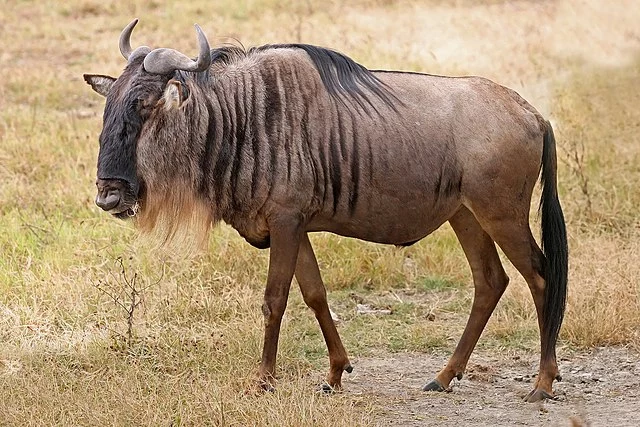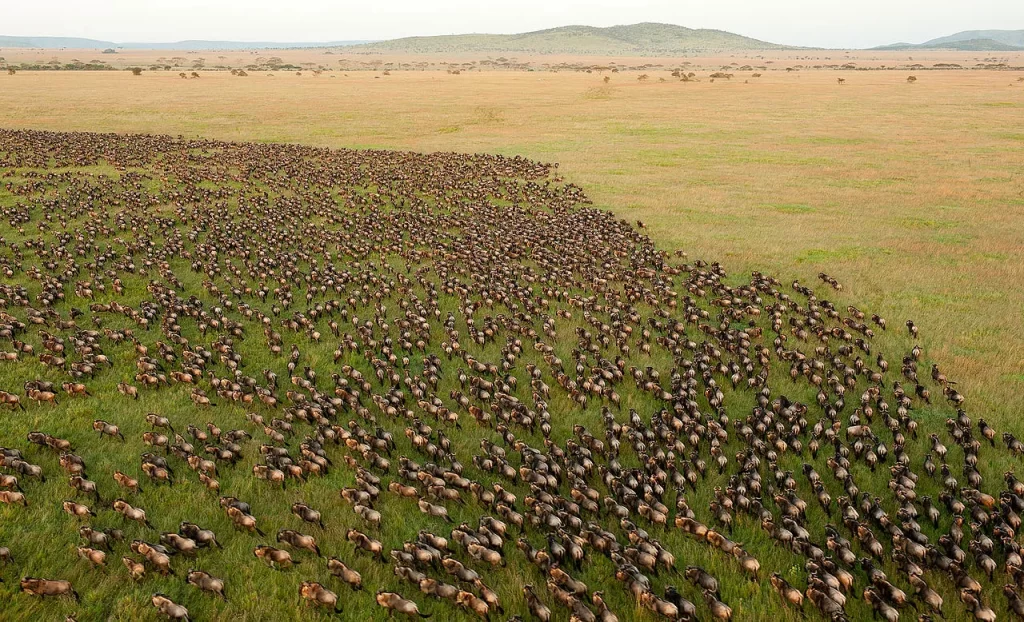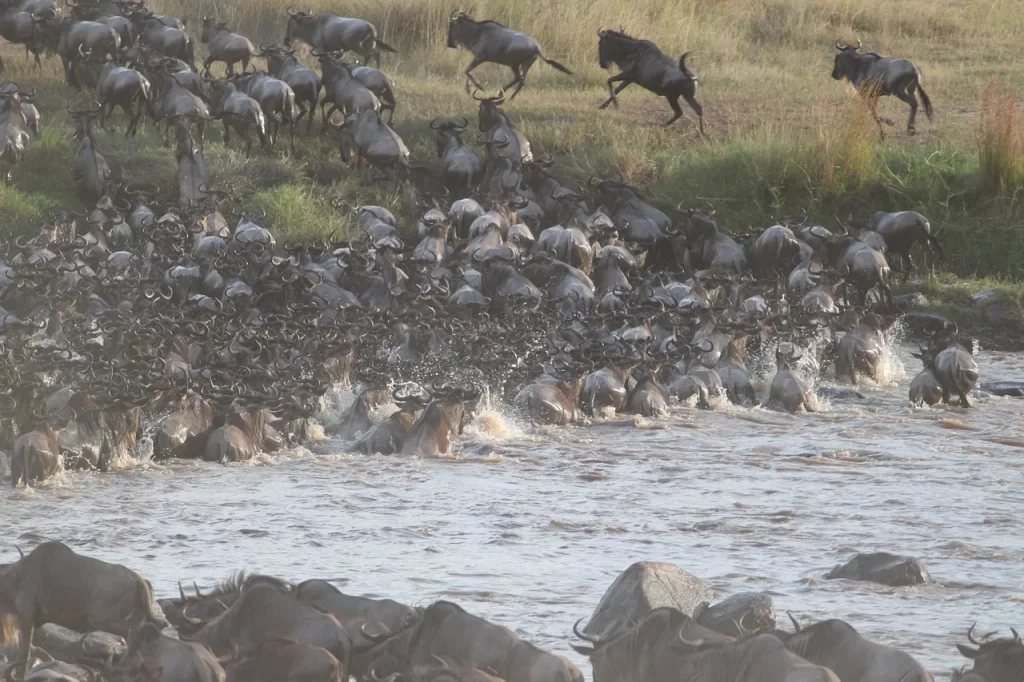A wildebeest is an animal that normally belongs to the antelope kindred or family. This is a group of animals commonly distinguished by their curved-like horn structures, head which is in the shape of a box and which holds the horns and is generally a hard structure of their body and they also have a muscular body structure. These animals are found mainly in areas with enough supply of water and food for their consumption and these areas include the grassland plains, the savannas, and also the woodlands. Another name that can be used to describe or name the wildebeests is the gnus. Apart from the antelopes, they also are an animal species in close distinction with the gazelle type of animals found in grasslands and woodlands. They inhabit most grass plains of Kenya and Tanzania and migrate in and out of these countries during specific times of the year depending on the season.

What makes the wildebeests known in many parts of the world is their mode of migration. Their migration involves the movement of large groups of these animals and mainly takes place during the end of every rainy season which is the year between May and November and migrate mainly to look for more pastures and adequate water for their consumption. This migration is a risky decision that they make especially when crossing rivers because these rivers contain giant crocodiles that are always ready to feed on them.
Some of the rivers that they cross through include the Sand River and Mara river found in Kenya and Tanzania respectively. The Mara river is situated on the border of Kenya and Tanzania and therefore shared by the two countries. The most ideal river for the crossing of the wildebeests that is known in most parts of the world is the Mara river which is a major tourist attraction site and a source of heritage for the country. This, therefore, means that it is also a major source of foreign exchange for the country.
This migration of the wildebeests following seasonal rains is usually considered the 8th wonder of the world. During the wildebeest migration, there also are other animals that move along in the same season. These include the zebras, gazelles, and impalas There exist many myths and misconceptions about how these animals manage to find their direction. They succeed in looking for their direction by swiftly responding to changes in the environment. They can trace weather patterns and move to areas where the weather is conducive for them to stay. Another element that makes them know which direction to follow is the instant growth of certain plants, especially the growth of grass. Wildebeests, therefore, use the above tactics to trace their direction and therefore move to places conducive to their living.
Where Do Wildebeest Migrate To And From?
The migration of wildebeests mainly takes place between two main countries which are Kenya and Tanzania. As mentioned earlier, wildebeests migrate into and out of these paces following regular weather patterns and different seasonal changes that come at different times of the year. They move mainly for their survival and their journey is not a walk in the park because it entails passing through big rivers which contain predators such as crocodiles. Other predators that the wildebeests face in their migration are lions, cheetahs, and hyenas.

Wildebeest migration takes place in different geographical areas in both Kenya and Tanzania. In Tanzania, wildebeest migration takes place in Ngorongoro up to the parts of Serengeti. These are the main places where one can spot wildebeests in Tanzania. In Kenya, they are popularly known to be found in Maasai Mara and migrate when there are no rains or when the pastures are depleted.
This migration starts from the Ngorongoro region up to the Serengeti plains. After reaching Serengeti they move in a clockwise direction heading towards Kenya, mainly through Maasai Mara national reserve and the cycle goes on the same route depending on the prevailing climatic conditions. It takes approximately up to one year for them to start the cycle again, that is, for them to move from Kenya back to Tanzania. More than 1.5 million wildebeests migrate from Kenya to Tanzania and back covering a distance of up to 1,000Km and move in groups of large herds showing how they are united.
This migration is however faced with different challenges on their way to their destination. One of the most tantamount risks that the wildebeests face during their migration is action by predators. These predators include lions, cheetahs, and hyenas. The most dangerous and common predators of the wildebeests are the crocodiles which reside in the rivers that the wildebeests use to cross to the other side. This, therefore, results in a slight decrease in the number of the wildebeests but their tactic of moving in large herds sometimes acts as a security for them.
Other challenges faced by the wildebeests during their migration include hunger whereby the quantity of pastures available is not enough to sustain all the animals that migrate. In addition, they face general body weakness due to hunger and also get thirsty due to the movement for long distances without a reliable source of water.
Why Do Wildebeest Migrate?
For a very long time, wildebeest migration has been a major tourist attraction, with many people visiting to experience the beautiful nature of this migration. Various reasons contribute to this migration and therefore they must move to other places, which otherwise helps save their lives from challenges such as death due to hunger and also lack of water. Furthermore, this migration mainly takes place during specific times of the year. For example, the wildebeests are found in Maasai Mara in the period between July and August, after that they move back to Serengeti.
Wildebeests migrate due to different changes in the rainfall patterns of the year which greatly determine their source of food and water. This movement makes them go to places with enough food for their consumption and adequate water for them to quench their thirst. In addition, the wildebeest migration is fostered by the fact that they move to look for safe places to naturally and freely interbreed to produce fertile offspring. This is one of the reasons that explain why they are normally in large numbers or in groups moving from a specific location and back when the prevailing conditions are effective for them. Without a safe place for them to interbreed it would therefore mean that these species of animals would keep on becoming extinct from one day to another.

The number of wildebeests that migrate is approximately more than 1.5 Million animals that move in a single group. As mentioned before, their large numbers are advantageous for them as this ensures they have some security from some of the predators and also ensures that there is continuity of generations of the wildebeests hence these species of animals are hard to become extinct. Calving among the wildebeests is also common and takes place in the period between December and March and is also a major reason why they migrate. This is the process by which the female wildebeests give birth or simply produce fertile offspring.
In every calving period, more than 8,000 wildebeests young ones are born since almost the whole population of females give birth at this particular time. The most common calving month is the month of January. This, therefore, explains vividly why the numbers of wildebeests are hard to decrease at a high rate. Migration for the wildebeests is, therefore, a tantamount practice for their survival.
When Can You See The Wildebeest Migration?

Wildebeests migrate at specific periods of the year depending on the prevailing climatic conditions and the rate and amount of rainfall at a given period. They move from Serengeti in Tanzania and then to Maasai Mara in Kenya and use the same cycle to move not unless there come harsh and tough climatic conditions. Since they are a major tourist attraction, many people from different parts of the world visit their main crossing places such as The Masai Mara, and watch them cross the Mara River to the other side where there are enough grazing lands to equally satisfy their large population or more than 1.5 million wildebeests.
The best and ideal time for one to see the wildebeests, especially in Maasai Mara is the period between late July and August. This is the time when they are seen crossing the Mara River over to the parts of Tanzania where they stay for a period of up to nine months and later on move back to Kenya still through the Mara River and stay in Kenya for about 3 months. In Tanzania, that is in Serengeti national park, they can be seen anytime between December and March whereas in Mara they can also be seen there in between May and November.
Their main points of crossing over are rivers, one of the main ones being the Mara River. These are the most dramatic and the most exciting scenes that many people come to watch and enjoy. They are termed as the most dramatic because this is whereby the wildebeests face the rough hand of the hungry crocodiles. As earlier mentioned, their movement in large herds minimizes the chances of most of them getting trapped by the giant crocodiles which are hungry.
The wildebeest migration is rarely seen throughout the year but can be watched at specific months and days of the year. These are one of the known animals for moving in large herds and that is why they are interesting to watch not only as they cross to the other side but also as they face the wrath of the hungry crocodiles. Sometimes this migration might be delayed due to reasons such as deterioration of rainfall and climatic conditions where these wildebeests live.
How Long Does Wildebeest Migration Last?
Wildebeests are one of the longest traveling animals ever known on the earth’s surface. Their migration takes place in a cycle, that is, they move from Korongoro and Serengeti in Tanzania up to Maasai Mara in Kenya. This cycle repeats itself every year following the different changes in rainfall and also the growth of grass.
The movement may however be delayed at some times due to insignificant changes in the climate of a certain place and the wildebeests end up staying in their current location awaiting the onset of rains in other regions for them to migrate to those places with enough pastures. Some of the other animals that migrate like the wildebeests such as the horses have the ability and a strong sense of smell that notifies them of places that have enough water and food for their survival.
The wildebeest migration period cannot be accurately predicted because sometimes they may fail to migrate if the conditions are unfavorable. The whole cycle, that is, migration from Tanzania into Kenya and back takes about one year with the normal weather conditions prevailing. At some times, the whole population of the wildebeests does not migrate but usually moves at specific intervals. One herd may decide to move earlier than the rest to follow after a certain period normally up to one week and at most two weeks. After their migration they stay in the country they have migrated into for a certain period.
Every year, there must be wildebeest migrations between Kenya and Tanzania. In Tanzania, they can be seen in Ngorongoro, though under very rare circumstances, and in the Serengeti region where they are mostly found for almost the entire period of the year. Since they spend most of their time in Serengeti National Park, they stay there for a period of up to 9 months before they change their route to migrate back into Kenya and repeat the same cycle over and over again.
If the climatic conditions between Kenya and Tanzania deteriorate over some time then this means that it would be a great threat to the wildebeest migration. This would not only reduce the migrations but also affect the rich wildlife heritage and reduce the number of visitors that come into the country to explore the natural environment. The rate of income from the foreign exchange would also be lowered and hence lower economic growth.
